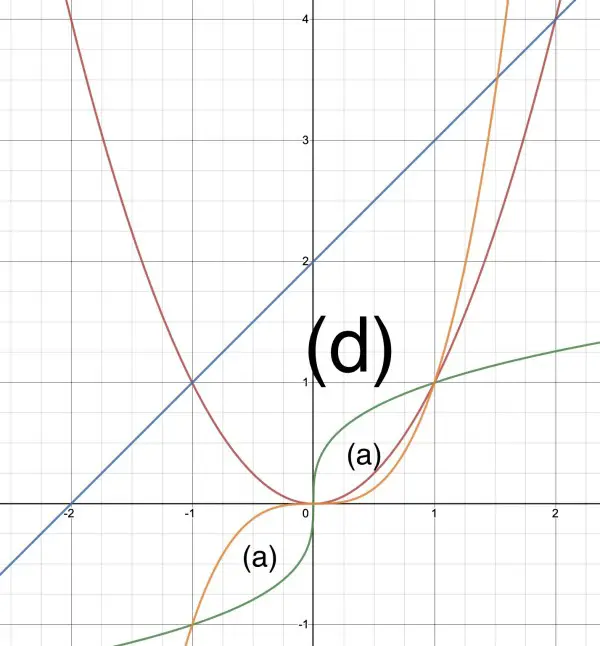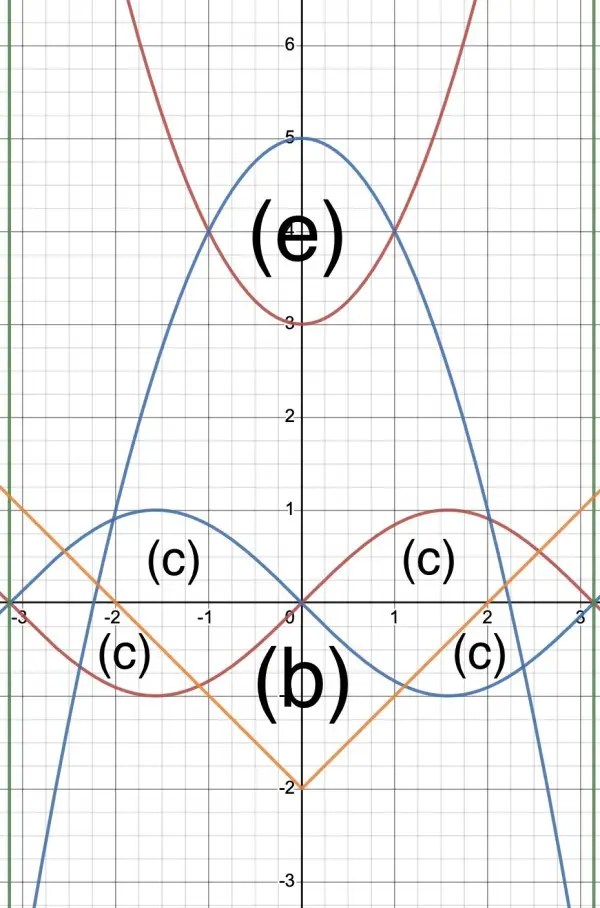(a) A rough sketch reveals two enclosed areas of the same size diagonally arranged on either side of the origin, with y=∛x forming the upper boundary and y=x3 forming the lower boundary. The points of intersection are found by equating the functions:
∛x=x3, x=x9, x9-x=0, x(x8-1)=0, x=0, -1 or 1, making the intersection points (-1,-1), (0,0), (1,1).
The area enclosed between (0,0) and (1,1)=0∫1(x⅓-x3)dx=[¾x4/3-¼x4]01=¾-¼=½.
Note that the area below the x-axis is [¼x4-¾x4/3]-10=0-(¼-¾)=½. Here, the upper boundary curve is y=x3 and the lower y=∛x.
The area enclosed between (-1,-1) and (0,0) is the same because of symmetry, so the total area enclosed is 1 square unit. See first picture below.
(b) Geometrically, this is an isosceles triangle hanging by its base between (-2,0) and (2,0), apex at (0,-2), and area=4 square units (the left and right sides of the triangle are each a diagonal of a 2 by 2 square, so the area of each triangle is half the area of its square). The question strictly requires the use of integration, so this follows next, but with the expectation of the same result.
Because of symmetry we need only find half the area by integration (using y=x-2 for the right half of the area):
0∫2(x-2)dx=[½x2-2x]02=2-4=-2. (The x-axis is y=0, so x-2=0, x=2 is the upper limit for x.) The area is negative because the area is below the x-axis. We need the magnitude, not the sign, so the area is 2 square units. The left area is also below the x-axis and is the same as the area on the right, making 4 square units, as expected by geometry. See second picture below.
(c) The symmetry here means we only need to calculate one area, and then multiply the result by 4. The sine wave oscillates about the x-axis. When x=0 the wave is above the axis and when x=π it crosses the axis and dips below it. When x=-π, the wave starts on the x=axis, dipping then rising to cross the axis again at x=0. y=-sin(x) does the opposite, forming two closed loops with y=sin(x). The integral 0∫πsin(x)dx=-[cos(x)]0π=-[cos(π)-cos(0)]=-(-1-1)=-(-2)=2 is all we need for one area above the x=axis. There are three other areas equal to this above and below the x-axis, so the total area=4×2=8 square units. See second picture below.
(d) The graphs intersect when x2=x+2, x2-x-2=0=(x-2)(x+1)⇒x=2 and -1.
-1 ∫2(x+2-x2)dx=[½x2+2x-⅓x3]-12=(2+4-8/3)-(½-2+⅓)=10/3-(-7/6)=10/3+7/6=27/6=9/2 square units.
(e) Intersection of two parabolas when x2+3=5-x2, 2x2=2, x=±1.
-1∫1(5-x2-(x2+3))dx=-1∫1(2-2x2)dx=[2x-⅔x3]-11=(2-⅔)-(-2+⅔)=4/3-(-4/3)=8/3 square units. See second picture below.
In the pictures below, the graphs are colour-coded and more than one set of graphs is displayed in the same picture to save space. The required area is shown using the question part identities (a) to (e). The area shapes can be extracted individually from the pictures and used any way you wish in your design.
GRAPHS

(a) labels each area making up part (a) in the question. Green curve is y=∛x, orange curve is y=x3.
(d) labels the area between the blue line and the red parabola: y=x2 is shown in red, y=x+2 is in blue.

(b) y=|x|-2 is shown in orange; (c) y=sin(x) is in red, y=-sin(x) is in blue (green verticals represent the lower and upper limits of the integral, x=-π and x=π); (e) y=x2+3 is in red, y=5-x2 is in blue.
The design of a pattern made up of arrangements of area shapes is left to personal choice. Note that all shapes are symmetrical except for (d), which could be used with its reflection(s) as part of your design. The labelled areas can be shaded by your own choice of colours.